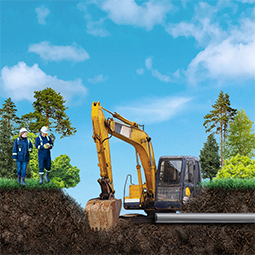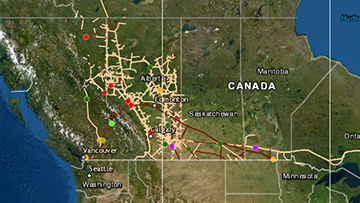Land Matters Guide

When you hear about a project being proposed on your land or on land in which you have an interest, you may have questions and concerns. The CER has produced this Land Matters Guide to help.
What you need to know
Below is a lifecycle graphic representing the CER’s regulatory oversight for the entire life of a federally regulated energy project (in this case a pipeline project). Click on the lifecycle headings to learn more.

Proposed Energy Project
Before the company can build a federally regulated pipeline, power line, or offshore renewable energy project, it must apply to the CER. The CER will review and assess the proposed project, including the company’s engagement activities and potential effects on people, property, and the environment. See how you can get involved by clicking on the topics below.
We expect companies to engage early about a project and demonstrate to us how it considered the information it gathered. Let the company know whether the project may affect you. The company will let potentially affected people and communities know when it files an application with the CER.
We will consult with Indigenous peoples early and throughout our review process. The scope and nature of the Crown consultation activities will be tailored to the complexity of the proposed project and its potential effects, and the needs of Indigenous peoples.
We rely on you to bring forward your concerns and views. If you have concerns about a project, you can send us a Statement of Concern within 21 days of the application being filed with the CER. Your concerns will guide the CER in planning its review.
The Commission of the CER assesses the project’s proposed design, construction and operation to make sure it’s safe, protects people and the environment, and it is in the public’s interest. The CER may hold a public hearing for facilities applications. If you have questions about the hearing process, contact a process advisor.
Once a project is approved, it may be necessary for the Commission to determine the best possible detailed route of the pipeline and the most appropriate methods and timing of its construction. To oppose the proposed detailed route, you will need to file a written statement of opposition with the CER.
If a company is unable to reach a land agreement for access to lands required for an authorized project, it may apply to the CER for a right of entry order. If you choose to object, you must file an Objection to an Application for Right of Entry within 10 days after receiving a copy of the company’s application.
The company must tell you what land it is planning to use to construct, operate, and maintain its proposed project. It may propose a land agreement with you to confirm the lands the company can work on.

Construction
We oversee construction of a project and check, for example, by doing on-site inspections, that companies are following requirements in acts, regulations, and the conditions of a project’s approval, certificate, order, or permit. We use these requirements and conditions to reduce risks, prevent harm, promote safety, and protect the environment. Once construction is finished, companies must begin work to return the area to a condition acceptable to both the landowner and to the CER. Visit the program pages below to learn more.
If you live or work near a pipeline, find out how to safely do your activities. Before you dig near a pipeline, get the company’s consent. Visit Click Before You Dig to locate buried pipelines or utility lines.
CER inspection officers regularly go out into the field to verify and enforce requirements and standards in place to keep people and the environment protected.
In an emergency, we make sure companies respond in a way that protects people, property, and the environment. We expect them to take the action needed to stop spills, manage the incident, and clean up and pay for any damage done.

Operation
The CER continues to monitor and assess operations. We do this through regular inspections, audits, and incident investigations to make sure the pipeline operator company complies with regulations that protect public safety, property, and the environment. Where Indigenous peoples have interests in the area of a project, the CER-regulated company may work with them so they can be involved in aspects of monitoring a project. Visit the program pages below to learn more.
If you live or work near a pipeline, find out how to safely do your activities. Before you dig near a pipeline, get the company’s consent. Visit Click Before You Dig to locate buried pipelines or utility lines.
CER inspection officers regularly go out into the field to verify and enforce requirements and standards in place to keep people and the environment protected.
In an emergency, we make sure companies respond in a way that protects people, property, and the environment. We expect them to take the action needed to stop spills, manage the incident, and clean up and pay for any damage done.

End of Life
The CER requires the company to make sure all necessary precautions are taken for safe decommissioning or abandonment of the pipeline or facility. This includes issues like use of the land, ground settling, soil erosion and land restoration. If a company decides to take a pipeline out of service temporarily (decommission) or permanently (abandon), the operator must file an application with the CER. See how you can get involved on the pages below.
This is an optional stage in a pipeline lifecycle that can happen prior to a pipeline abandonment. Decommissioning is when a company shuts down the operation of a pipeline, but service is still provided through other pipelines owned by the operator.
If a pipeline is abandoned in place, the CER continues to regulate the pipeline and requires companies to monitor and report on them. Even after the restoration work is over, pipeline companies have an ongoing responsibility to landowners and the public to ensure the pipeline right-of way and the associated facilities remain safe.
Compensation disputes
The company must compensate you for land acquisition, restricted use of lands, or damages caused by its activities. If parties are unable to resolve a land-related compensation dispute related to a project regulated by the CER amongst themselves, the CER can support resolution.
For an overview of how you can bring land-related compensation disputes to the CER, see Land use compensation.
For more in-depth information on the application and adjudication process when you bring compensation disputes to the CER for compensation payable under Part 6 of the Canadian Energy Regulator Act, see the CER’s Guidance on land-related compensation disputes.
Services available throughout the lifecycle
The Land Matters Advisory Service (LMAS): If you have questions about land matters with respect to CER-regulated energy projects and processes, email LMAS.SCQF@cer-rec.gc.ca.
Alternative dispute resolution: Any time during the life of a project, if you are unable to resolve concerns directly with the company, you can email ADR-RED@cer-rec.gc.ca to ask a specialist to work with you and the company to find solutions.
Complaint resolution: If you are unable to resolve an issue with a CER-regulated company, facility, or activity on lands you use or own, you can send us a completed Complaint Form.
Related publications
The CER, Energy Projects, and
Indigenous Peoples
Features
Interactive pipeline map
Living and working near pipelines
- Date modified:






